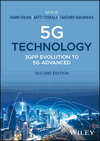5G Modem Design Challenges
Summary
5G NR – the new radio access technology at the heart of the 5G system – is designed to push the boundaries of mobile communications to unprecedented levels in terms of data rates, latency, reliability, and connectivity. This chapter exposes the many challenges facing the 5G NR modem design and the solutions implemented to address those. Each part in this chapter focuses on one key NR feature and its associated modem impacts with a particular emphasis on the main challenge to overcome. First, high data rates and system flexibility are discussed, focusing on tackling the associated computational complexity issue. Then, low latency and flexible frame structure are addressed from the main standpoint of control flow complexity. Thereafter, multi-RAT coexistence and the challenge it poses on modem architecture are debated. Finally, NR wide bandwidth operation is analyzed in relation to power consumption.



